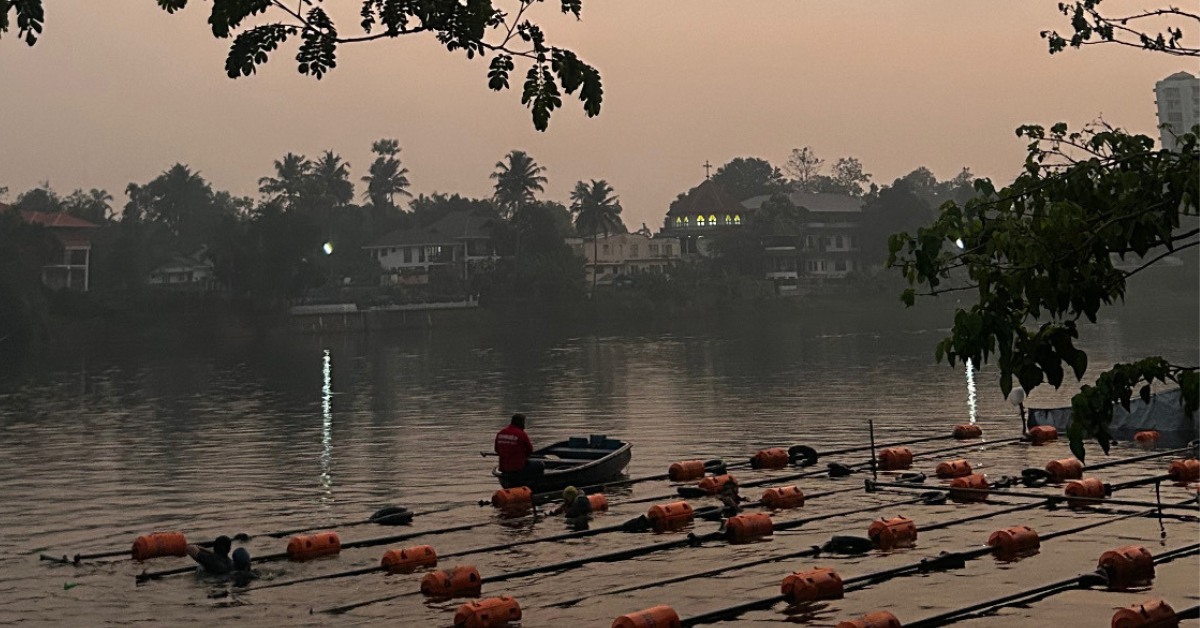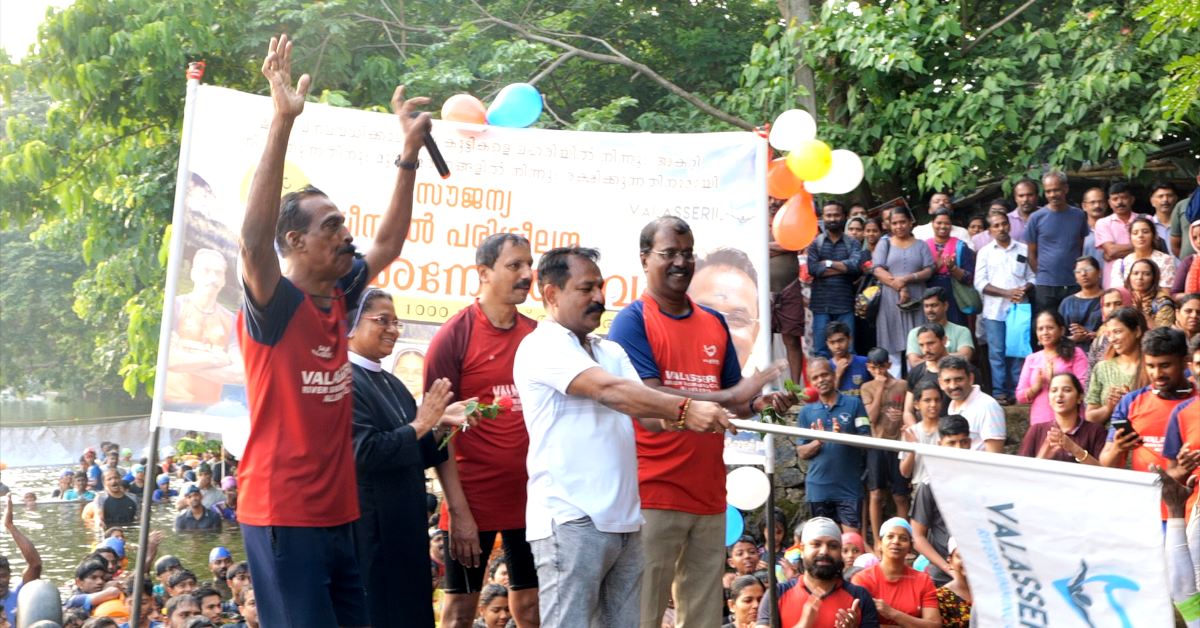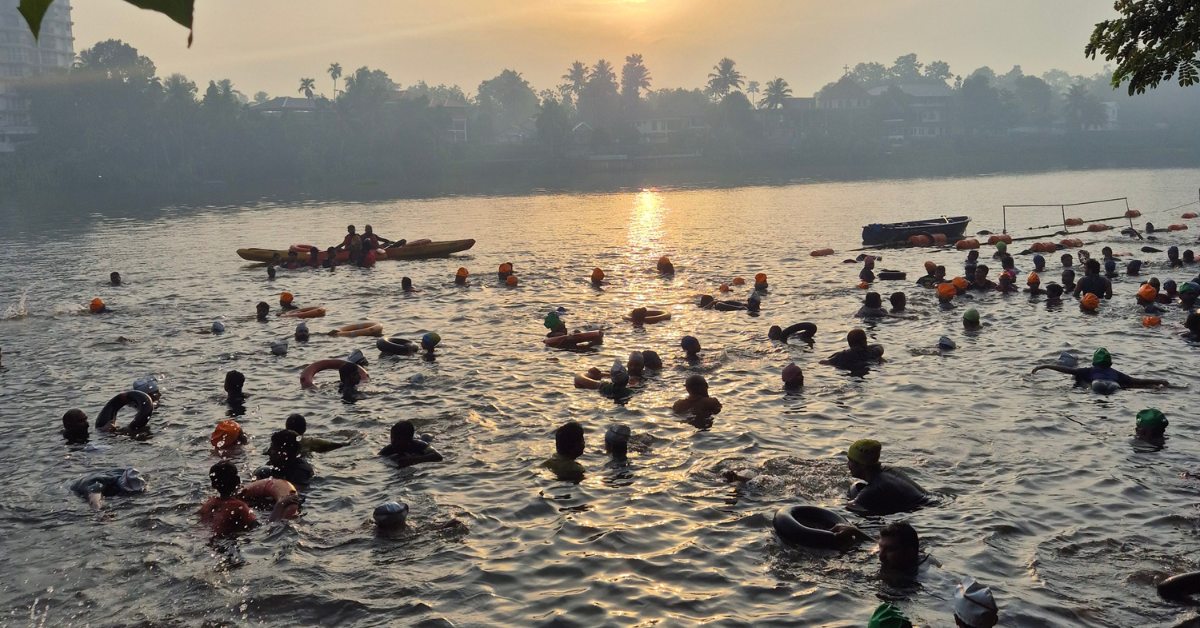How 1 Kerala Resident Taught Over 10000 People to Swim & Conquer Their Fear of Water
On a quiet February morning in 2009, a school picnic to the scenic Thattekkad bird sanctuary near the Periyar river, turned into a tragedy. A boat carrying 15 kids and their teacher capsized in the river, leaving no survivors. The tragedy shook Saji Valassery, a humble furniture shop owner, to his core. Haunted by the thought of the young lives lost, he began taking swimming classes in the very river that had taken them, for free.
Little did he know that this simple gesture would turn the sombre banks of the Periyar into a place filled with laughter, learning, and the warmth of community.
‘You only need 16 days to learn how to remove your fear of water’
It all started with a simple but powerful thought—Saji didn’t want to see another life lost to drowning. So he began small. He taught his own kids to swim, then their friends, then a few kids from around the neighbourhood. They learned to float, paddle, and stay calm in the river’s current.
Word spread. More kids came. Then adults. Slowly, the group grew. What began as a handful of kids splashing around turned into something much bigger.
Today, that small effort has become the ‘Valasseril River Swimming Club’. Over 10,000 people have learned to swim here. And in an incredible milestone, 2,000 children have been trained to swim across 780 metres of river—all in one go.
 The club has people of all ages, sizes and backgrounds coming for classes.
The club has people of all ages, sizes and backgrounds coming for classes.
It’s not just about swimming. It’s about safety, courage, and a father’s quiet determination to make sure no one else has to lose someone to the water.
“The fear of water is the biggest problem. Most drowning cases reported here are of people boating close to the banks and not in the middle of the river,” says Saji. Muscles sore from old age or even the lack of two limbs have not stood in the way of the 60-year-old Saji, who has taught people of all ages, sizes, and abilities to conquer the water. 10 children with physical disabilities have been empowered to cross the river so far.
“You only need 16 days to learn how to remove your fear of water and save yourself from drowning,” he proclaims, introducing his carefully crafted swimming program that promises to teach anyone how to swim in just over two weeks.
At the heart of this unique setup are floaties and tyre tubes tied together to form narrow lanes on the water, arranged like a giant floating jigsaw puzzle. These lanes serve as different levels of training—an inventive system Saji developed over years of trial and error. The levels range from ‘pre-lower kindergarten’ all the way to ‘post doctorate’, a playful but purposeful way to mark progress.
 Classes are run with the help of dedicated volunteers who come every day to ensure that the crowd is organised and safe.
Classes are run with the help of dedicated volunteers who come every day to ensure that the crowd is organised and safe.
Within these floating lines, hundreds of people learn to swim every day, guided not just by Saji, but by the many former students who now return as passionate volunteers, paying it forward, one stroke at a time.
At this river, everyone starts equal
Every day, at the break of dawn, they gather by the river. The volunteers quietly take their places, dividing up the day’s responsibilities so that Saji—the heart of it all—can focus on teaching every single person who’s shown up to learn.
Here, titles and backgrounds are left at the shore. Whether you’re a police officer, a daily wage worker, or a school kid, everyone starts at the same place: pre-LKG. In the water, no one is above or below the other. It’s not about who you are outside—it’s about who you’re becoming here.
“The discipline we inculcate through our classes here, the shared sense of community and mutual appreciation, make this a learning environment people look forward to. All kinds of people come together, young and old, men and women, from diverse professions, backgrounds and belief systems. We don’t see any of those differences. No one is looked down or looked up, there’s only teaching,” Saji says.
This welcomes a diverse community where some come to learn, others for the health benefits and many for the joy of being part of an inclusive space. Jeggi Paul, a community member says, “I came in 2019 but didn’t think I could swim because I had surgery
Not just a swim, a second home
With so many people sharing the space, the swimming club follows a few simple but thoughtful rules to keep things safe and respectful. One of them is that women and children must be accompanied by a bystander — someone who can watch over them from a designated seating area throughout their time at the river.
 The swimming classes have also grown into a space for sharing knowledge and stories, where everyone who learns is gently encouraged to give back
The swimming classes have also grown into a space for sharing knowledge and stories, where everyone who learns is gently encouraged to give back
That’s how 65-year-old Arun Lal first found himself at the Valasseril River Swimming Club. Back in 2016, he came along just to watch his grandkids swim, following the guardian rule. But something unexpected happened. “I came to sit and watch my grandkids swim because of the rule that a guardian has to be present at all times,” he says. “But the atmosphere of the place, the camaraderie between everyone, and being so close to nature made this place my respite.” Now, years later, he’s still here—every morning—no longer just a bystander, but a swimmer himself.
Others come with big dreams in their hearts. Galin Abraham, who completed the Ultra Space Race, trains here to prepare for his next challenge: swimming across the English Channel. And then there’s John Jose, who boards a train every morning, travelling 60 kilometres from Thrissur just to attend the classes. Some even come from as far as Mumbai, finding temporary homes along the riverbank just to be part of this unique, life-changing experience.
Why do they keep coming back
The swimming classes have also grown into a space for sharing knowledge and stories, where everyone who learns is gently encouraged to give back, keeping the spirit of community flowing as steadily as the river itself. “Even though the classes are free, we all give back to the community here. Once anyone clears their post-graduation level, they are required to do 6 days of compulsory service, to ensure the safety of other groups,” explains Denny Varghese, who has been part of the community since 2010.
“I take days off from work to go and spread awareness about these classes—to speak to parents, to urge them to make sure their children learn how to survive in water,” he shares with quiet conviction.
 Saji Valassery’s discipline and passion are shown in every aspect of these classes, and make it possible to train these large groups of people at once.
Saji Valassery’s discipline and passion are shown in every aspect of these classes, and make it possible to train these large groups of people at once.
The urgency behind his efforts is real. In 2024 alone, 524 people—including 77 children—lost their lives after falling into waterbodies across Kerala. In response, the team has taken their mission beyond the riverbanks. On February 27th, they’re bringing their message to the public through an awareness campaign in the Kochi Metro, speaking directly to passengers, one train ride at a time.
On average, more than three people drown daily, according to the cases reported in the state the past few years. Valasseril River Swimming Club teaches over 1000 people every year from November to May. It pauses during the monsoon season and reopens in November, when the river is calm and safe again. Every November, when it restarts, volunteers return on their own, led by excitement and their shared sense of purpose. “Saji’s pure passion towards the cause, his discipline in implementing it and his positive character keep me and many others inspired to keep coming back here. He has never accepted any monetary benefit, even if it was offered and that makes me want to show up for him and his cause,” adds Denny.
A quiet hum of excitement at 5:30 AM
Among the many lives Saji has touched, one story stands out. Aasim Velimanna, a differently-abled rights activist and motivational speaker, is now also a swimmer — thanks to Saji’s quiet persistence and belief in his potential. For two years, Saji gently built trust with Aasim’s parents, reassuring them that their son could safely learn to swim. When they finally agreed, he trained Aasim not just to float or paddle, but to cross the river. It was a powerful moment, not just for Aasim but for everyone who watched him break through perceived limits.
The river has seen many such milestones. One of Saji’s young students even made it to the Asian Book of Records for completing the longest solo open sea swim by a child — a feat born not of ambition alone, but of the joyful, disciplined training nurtured here each day.
By 5:30 AM every morning, a quiet hum of excitement fills the air as the community gathers. Children, parents, elders all assemble along the water’s edge. Saji begins with gentle stretches and simple exercises, weaving in warmth and joy with stories and playful games. He turns safety drills into moments of fun, asking children if they know how to find their way home, encouraging impromptu performances, filling the air with laughter.
As the sun rises, it casts its glow on a riverbank filled with smiling, spirited faces, ready to greet the water. When asked what keeps people coming back, Saji simply says, “People go to places where they find happiness. Then swimming just becomes an added benefit.”
Edited by Leila Badyari; All pictures courtesy Valassery Swimming Club
News